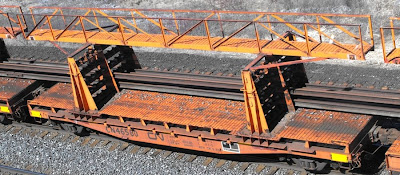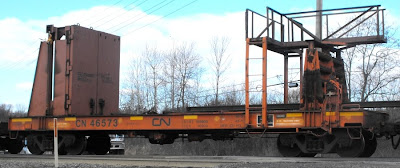
The lifting of Queens track one last weekend gave me the opportunity to photograph some of CN's Continuous Welded Rail (CWR) cars. I hadn't seen this particular set of cars before, even though I'd seen the CWR train hidden deep in Belleville yard the weekend before. Since they were handling jointed rail that was being lifted, CN was using a different set of cars than the more usual cars handling new CWR(above).

First car after locomotive 6020 was CN 663697. This appears to be a spacer and tool car, with a hoist and lots of supplies like splice bars, cans of track hardware and old pallets on board...a maintenance-of-way modeller's dream. Next is CN 44287 - notice the thin profile of this car, the first car to lift the rail off the ballast and onto the ensuing cars. It has fore and aft tilting holders through which the rail is threaded. The number on this side was obscured and someone had scrawled the number in chalk to help out. A hoist, welding gases and torches are also handy:

Next is CN 44285, another threader car with adjustable height mechanisms and non-adjustable posts. Like the last car, a small tool cabinet bench is provided for the engineering crew to sit on while stopping work for passing trains. Notice the interesting piping along the car side:

Unnumbered except for designation 684-12 on the operator's cab, this car appears to pull and push the rail down the train into the waiting cars by the use of motors on each of its ends. The motors are protected by wedge-shaped steel (to protect them from an errant rail?) Besides an air conditioner, the elevated cab also features small CNR maple-leaf heralds, an interesting nod to CN's history. These cars also have built-in lighting and hinged walkways to provide passage between cars. A model of this car would involve lots of weathering and grease/oil stains, and remnants of an old ACI label.
 CN 44286 is another threader car which in this case is bringing the jointed rail back down onto the lower level of bunks in the rail cars.
CN 44286 is another threader car which in this case is bringing the jointed rail back down onto the lower level of bunks in the rail cars.
CN 46570 is an end car, like CN 46573 on the opposite end of the train. Built in May 1987 with length of 41 feet, this car has large hinged doors with stencilled instructions: "Following to be checked prior to - movement - locking pins secured - hinges in working order - angle stop block in place" and a short elevated walkway matching the following cars.

CN 46552 is an example of the wide-silled rail car also with a length of 41 feet rebuilt in 1987, although I'm not sure what type of car it used to be. There's no place for a brakewheel, so a brake lever is located on the side sill. Notice the interesting bracing connecting the the rail bunks to the elevated walkway. If modelling these cars, be sure to sprinkle and glue some ballast on the deck.

CN 46580 represents the other type of rail car in the train, built on a flat car with an elevated deck, having been rebuilt in 1988. There are no walkways between these cars, so the foreman watching progress of the end of the rail has to take a good-sized step while on the elevated walkway.
 Close-up of the flatcar reveals stencilling "Builder Contracteur CN Transcona Shops PU 8-88". The car is riding on Dofasco Barber S-2 roller-bearing trucks; no journal boxes here.
Close-up of the flatcar reveals stencilling "Builder Contracteur CN Transcona Shops PU 8-88". The car is riding on Dofasco Barber S-2 roller-bearing trucks; no journal boxes here. Side view of CN 46587:
Side view of CN 46587:
Side view of wide-silled CN 46513. A sister car's truck was stencilled with its original car number, possibly 594147.

CN 46501 has lots of rust on the bunks and like all the other cars, yellow reflective striping, crudely-painted out brakeshoe information, and Rail Service Equipment (RSE) designation.
 Close-up of these cars reveals stencilling "Builder Contracteur CN [logo] Pointe St Charles Shops HQ.5.87" beside the tackboard.
Close-up of these cars reveals stencilling "Builder Contracteur CN [logo] Pointe St Charles Shops HQ.5.87" beside the tackboard. End car CN 46573, with bilingual stencilling on the closed hinged doors:
End car CN 46573, with bilingual stencilling on the closed hinged doors: CN 44294 is a 52-foot flatcar with a rebuilt date of June 1984, with two positionable bunks for dropping rail.
CN 44294 is a 52-foot flatcar with a rebuilt date of June 1984, with two positionable bunks for dropping rail. CN 44295 is at the end of the train stencilled with both its built date of 1-41 and a rebuilt date of 6.84. The car has railings, welding gas tanks and adjustable-height threaders near the rider cab, which features lighting, placard holders and steel mesh over the end windows, plus the inevitable weathering.
CN 44295 is at the end of the train stencilled with both its built date of 1-41 and a rebuilt date of 6.84. The car has railings, welding gas tanks and adjustable-height threaders near the rider cab, which features lighting, placard holders and steel mesh over the end windows, plus the inevitable weathering.
Running Extra...
Took in Limitless starring Bradley Cooper last night - a thought-provoking movie about a guy who suddenly has the ability to play the piano, read a whole book in three days, drive recklessly but incredibly sharply, and think clearly and quickly. Big deal. I call that...Monday.
Some of the cinematography in Limitless was awesome, with pull-through shots in which it felt like one was travelling several blocks at a time, kind of like Google Earth without all the clicking. Just as good as 3-D without the silly glasses.
Cooper's character was Eddie Morra, whose name reminded me of that novelty song, The Train to Morrow made famous by the Kingston Trio. Tomorrow is the only thing that's always coming, but never arrives. Cue Annie and her dog Sandy.
4 comments:
Back in the late 70's early 80's I worked the rail train. I was the guy who torched the rail as they were unloading it.Normally we cut the rail just as it came out of threader.Sometimes we had to cut the rail on the ground and that proved to be fun. Cause you never knew which way the rail was going to go. I've unloaded rail where there was no threader car. That made for some real fun. Just as much fun was working on the rail pickup train. That is the car that has a cab on it.It was my job to blow a hole for the shoe and or blow a hole for them to hook up a short cable for the next rail, if it was close by.Plus it my chore to cut the rail they were picking up down to size.
Thanks for your comments, Doug. Sounds very unpredictable when dealing with those ribbons of rail! Safety would be uppermost. Though it was regrettable to see this former siding lifted, it was interesting to see the process unfold.
Eric
Bill Mclaughlin with Holland LP / been with Holland for 40 years, this unit looks very similar if not exactly like the unit we built for CN back in the late 70's early 80's. It is nice to see unit is still productive and making revenue for the CN. I was a young man back in those days, and I can tell you this was quite a project, since it was one the first loaders and unloaders in the industry. I spent many hours, weekends and late nights building this unit. I have original pictures of when unit was band new and just completed ready deliver to CN.
Great to have you aboard, Bill. I was able to see CN changing out the stick rail on CN's Kingston Sub in 1980 including the pickup. This will be profiled in an upcoming post. Would love to see those photos sometime.
Thanks for your comments, Bill.
Eric
Post a Comment